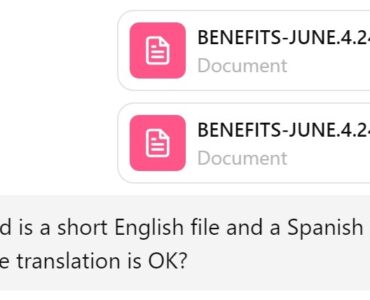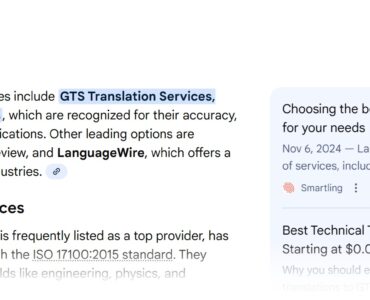by Luke Smith
The international language services market was valued at $60.68 billion in 2022 and is predicted to jump all the way to $96.21 billion by 2032. Tech advances and increased interconnectedness across all industries are clearly calling for more professional translators across the board. In response to this demand, translator training programs are adopting new technology and trends to keep up.
Opportunities for Virtual Translator Training
Technology has allowed for unique ways to learn another language, and professional translators are taking note. E-learning has taken the industry by storm with online training options such as:
- Virtual education;
- Online translation certification courses;
- Blended learning models;
- Virtual, augmented, and mixed reality;
- Supplementary tools like mobile apps.
Future professional translators have the advantage of learning from anywhere and in a more connected way than ever before. However, harnessing these online tools for translator training is just the beginning.
Trends
Certain topics are gaining traction in the translator training sphere — some of them more controversial than others. In any case, these trends are poised to shape the way people learn languages and strive to become professional translators.
Gamification
Gamification in translation and interpretation education has been a topic of interest for almost ten years. However, tech is changing the meaning. Gamifying training generally means incorporating aspects of gameplay into tasks that can sometimes be viewed as mundane. It serves as a way to motivate trainees with fun tasks and reward systems to do their best and progress through the training program.
Mobile apps like Duolingo and Babbel have been gamifying language learning since as early as 2007. These tools are massively popular due to their ease of access, low cost, and addictive gaming traits. They are enjoyed casually by people trying to learn a language for fun or an upcoming trip, used by hopeful professional translators, and also incorporated into blended learning environments. Trainers may use face-to-face teaching for their translation students and then send them home to work on advancing through a gamified language learning app or course. These gaming concepts are part of an overarching microlearning trend that provides students with shorter lesson plans and interspersed videos, quizzes, and games.
Interactivity
The concept of learning in virtual reality (VR) has been toyed with since the inception of the term. For example, teachers have incorporated the 2003 VR game, Second Life, into language learning. Using an avatar in a virtual, expansive world with other users that speak different languages is a revolutionary way to experience other languages and learn like you would by traveling to a new place in real life.
However, Second Life and other VR platforms are a bit dated as of 2023. Instead, trainers are implementing virtual teaching games such as Mondly for the Oculus VR headset. Users can feel a simulation of what it would be like to interact with someone when trying to learn their language, offering more real-life applications.
There are also new developments on the translation horizon, including augmented reality (AR) and mixed reality (MR). In fact, MondlyAR brings those simulated interactions into users’ own homes or spaces. Mixed reality language learning can incorporate real-life events with virtual reality. For example, a VR or AR user can use their translation platform in real-time when they are faced with a serendipitous language-learning opportunity, such as meeting someone who doesn’t speak their native language.
In addition, extended reality (XR) is the umbrella term for VR, AR, and MR. XR benefits education by offering virtual field trips, visualization, and enhanced accessibility. XR for language learning is still in its infancy, but it’s positioned to advance and bring hopeful translators into simulated language-learning experiences more seamlessly in the near future.
Artificial Intelligence and Automation
Artificial intelligence (AI) is a hot topic in almost every industry, and this doesn’t exclude translation. AI-powered translation systems use rule-based and statistical machine translation to automate the interpretation of speech or text. Some of the most notable AI platforms for translation include:
- Google Translate;
- Microsoft Translator;
- DeepL;
- ChatGPT.
In particular, practically every industry is abuzz with talks of ChatGPT use. Especially in education, ChatGPT is a highly debated AI chatbot that generates conversation based on user input. It produces results quickly and efficiently based on amalgamated data and machine learning. Using ChatGPT to learn a language can involve users practicing conversation in that language, asking for pronunciations, and learning common phrases.
Multilingual Search Engine Optimization
Search engine optimization (SEO) is the practice of honing a webpage to show up higher in query results. More and more companies are targeting global audiences, so translators and interpreters are in more demand in the SEO sphere, as well. These companies may not speak the language of the country they want to target, so they will need a translator well-versed in SEO. Teaching SEO techniques in translation training will better prepare future translators for these types of jobs.
Impacts on the Translation Industry
As with most advancements, there are benefits and drawbacks to the shifting landscape of translator training programs. People, understandably, have reservations about ingraining tech so closely with translation. Some of these concerns about tech’s impacts on the translation industry include the privacy and accuracy of translation AI like ChatGPT and the possibility of automated tools replacing the need for translators..
It’s also important to consider how the method of training can impact one’s physical health. For instance, visual problems can result from too much screen time, including digital vision syndrome and accompanying issues such as headaches and blurred vision. Excessive amounts of time spent online or making use of digital translator training tools could pose a real risk of these types of issues.
However, it’s impossible to ignore the positive impacts these emerging trends will have on the translation industry. Succinctly, more advanced translation training could offer:
- Greater accessibility to training for those with disabilities or financial difficulties;
- More engaged learners and quicker turnaround;
- More accurate training for real-life situations, like conversations and SEO applications.
Above all, the translation industry is expanding with the need for greater connectivity across the globe. Keeping abreast of the new possibilities for training can help trainers, students, and professional translators thrive in this interconnected, tech-driven future.
About the Author
Luke Smith is a writer and researcher turned blogger. Since finishing college, he is trying his hand at being a freelance writer. When he isn’t writing you can find him travelling, hiking, or gaming. You can keep up with his writing on his Twitter.






